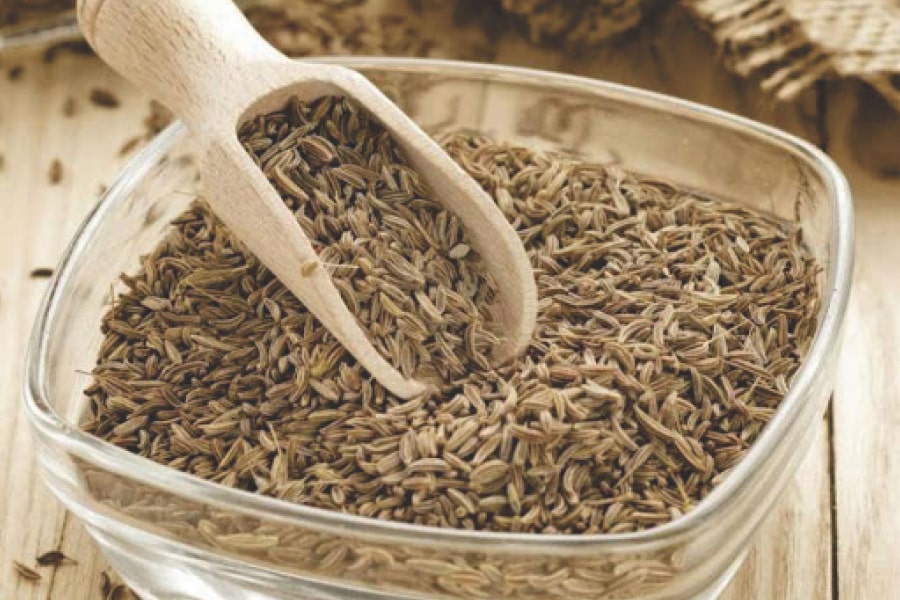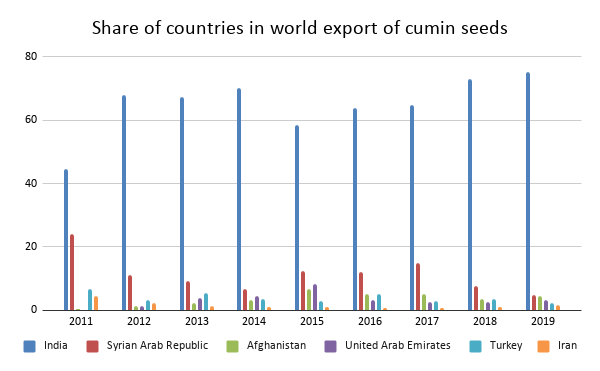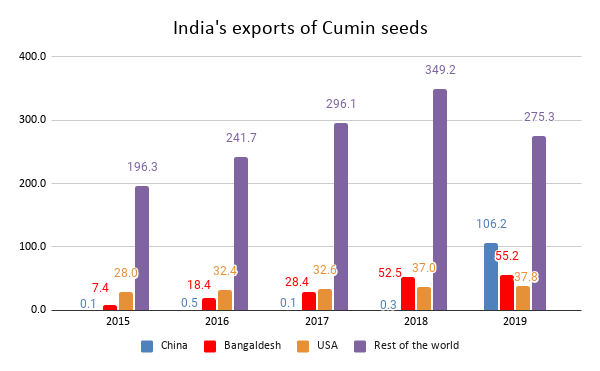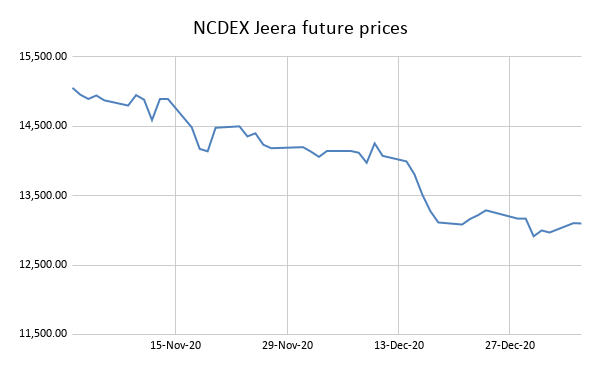Cumin seeds exports: Sailing with the tide
India has emerged the largest exporter of cumin seeds globally in the past few years, accounting for 75% of world exports. Boosting exports further would require capping of domestic prices and educating farmers in better cultivation methods.
- India is the largest exporter of cumin seeds, with a share of 75% in world export of the product in 2019. Furthermore, the country’s share has increased by 30.4 percentage points since 2011.
- Fall in export of cumin seeds of other countries and rise in production are some factors contributing to the increase in exports. The demand for the Indian cumin seeds is high from China, Bangladesh, and the USA
- India exports around 20% of its production of cumin seeds. 75% of the production is consumed domestically.
- Furthermore, high domestic prices also affect export incentives for cumin seeds.

Cumin seed, commonly known as Jeera in India, is a member of the Apiaceae family. With its origin in Egypt and the Middle East, the product is a well-known name in Indian kitchens. It is also well regarded for numerous health benefits like addressing digestion problems, boosting immunity, controlling blood sugar, and many more. Due to its many uses, the product has significant demand worldwide. Top importers of cumin seeds across the globe are China, Bangladesh, US, Egypt, UAE, and Saudi Arabia; together accounting for more than half of the import demand for the seeds in 2019.
Among these importers, China has the largest share of 19% in total cumin seeds’ imports. One interesting point to note here is that as per data, China had an insignificant share (0.1%) in world imports of cumin seeds until 2018. However, in 2019, the country had a share of 19% in the world imports of cumin seeds.
Industry insiders reveal that China is importing vast quantities of cumin seeds for value addition and possibly even re-exports. Another possible factor is increased seafood consumption in China, which is expected to lead to an additional demand of 6-18 million tons of seafood. China lowered tariffs on a total of 8,549 products for India and other 4 Asian countries under the Asia-Pacific Trade Agreement (APTA). The products included medical products, agricultural, chemicals, and, clothing, steel, and aluminum products. Currently, China imposes a 7.5% tariff on the APTA member countries, while the MFN tariff rate imposed by China is 15%.
Growing international presence
India is the largest exporter of cumin seeds with a share of 75% in 2019. Furthermore, since 2011, India has experienced a significant increase of 30.4 percentage points in its share, growing at a CAGR of 6.75%. This has been in part due to the fall in share of other top exporters. Some other countries with a significant share in the world’s export of cumin seeds are Syria (4.7%), Afghanistan (4.5%), UAE (3.3%), and Turkey (2.1%).
The share of Syria in cumin seeds exports’ has fallen from 24% in 2011 to 4.7% in 2019, experiencing an increase in share in 2015 and 2017. Similarly, Turkey’s share dropped from 6.6% in 2011 to 2.1% in 2019. The reasons for the decrease in share of both countries are political disruptions and a fall in cultivation of seeds. The share of Iran stood at 1.7% in 2019, declining from 4.4% in 2011. The share of Afghanistan has declined from 6.7% in 2015 to 4.5% in 2019, while for UAE, it has declined from 8.3% in 2015 to 3.3% in 2019.

Source: UN Comtrade, figures in %
The top destinations for Indian cumin seeds are China, Bangladesh, and the US, together accounting for a share of 41.9% in India’s exports. Export to China has increased from US$ 0.26 million in 2015 to US$ 106.17 million in 2019. Similarly, exports to Bangladesh and the US have also increased at CAGRs of 65.5% and 7.8% respectively, further implying increased demand for Indian cumin seeds in the world market.

Source: UN Comtrade, figures in US$ million
A look at the production trend
The domestic production of the seeds in India is aligning itself with the growing demand. Around 99% of the production of cumin seeds is done in Gujarat and Rajasthan. As can be seen in the table below, production of cumin seeds has increased from 503.26 thousand tons in 2015-16 to an estimated 699.54 thousand tons in 2018-19.
However, for 2019-20, the advance estimate for production is 546.75 thousand tons, lower than the production in the previous two years. The country exports around 20% of its production. In 2018-19, 25.7% of the production of cumin seeds was exported. The area under production has also increased during 2017-18 and 2018-19.
Production of cumin seeds
| Year | Area (in hectares) | Production (in tonnes) |
| 2015-16 | 808.23 | 503.26 |
| 2016-17 | 780.92 | 500.36 |
| 2017-18 | 966.17 | 689.42 |
| 2018-19* | 1026.76 | 699.54 |
| 2019-20** | 841.94 | 546.75 |
*Estimate; **Advance estimate
Source: Spices Board of India
In 2020, exports of Indian cumin seeds experienced contraction due to the Covid-19 pandemic. During March-May 2020, the YoY growth was negative owing to the fall in exports to major destinations including China, Bangladesh, and the US. However, the benefits of cumin in terms of improving immunity have helped in boosting its exports since then. Exports of cumin seeds grew by around 33% YoY during June-November, 2020.
Need for a further boost
Despite being the world’s largest exporter of cumin seeds, India exports a significantly small portion of its production. One reason for this is the high domestic consumption of cumin seeds, which is 75% of the total production in India. Another factor responsible is high domestic prices which overshadow the export incentives. As per Yashodhan Shah, MD at Virdhara International, exporters realise a lower margin in exports of cumin seeds in comparison to the domestic market. Domestic prices fluctuate in response to conditions like heavy monsoon during the season of the harvest, which affects the quality of output and raises the prices.

Source: NCDEX
The NCDEX future index for March 2021 expiry in the above graph shows that the future prices for the cumin seeds would be stable in India with the prices remaining between Rs. 13,000 a quintal and Rs.13,500 a quintal since 21 December 2020. Before that, the prices had been declining. To promote exports of cumin seeds, it is required to put an adequate cap on domestic prices. Furthermore, education of farmers and better cultivation methods would also contribute to export growth.













Leave a comment